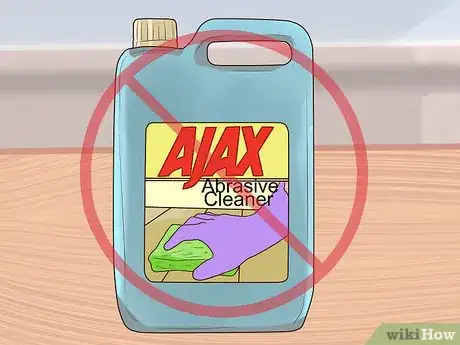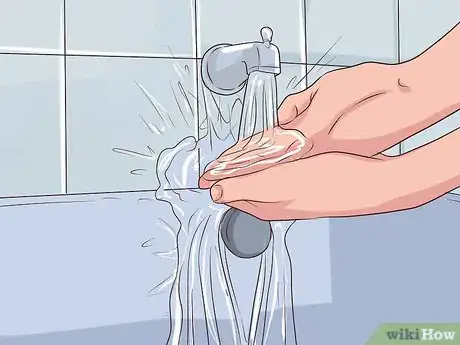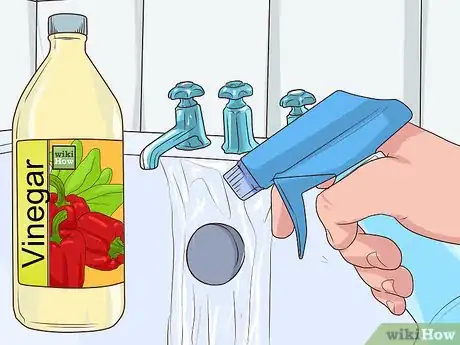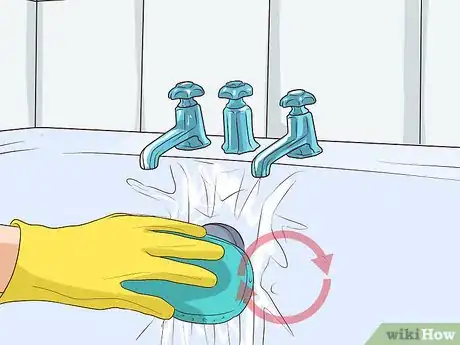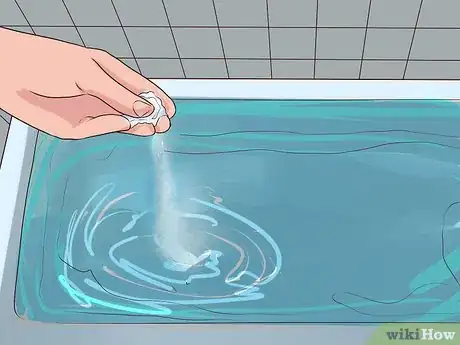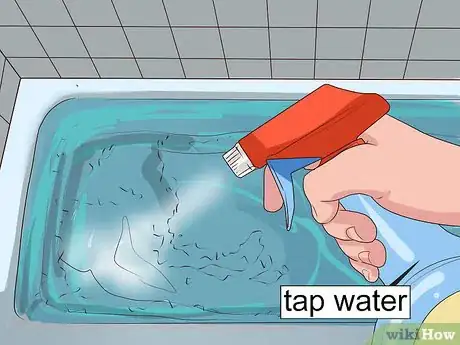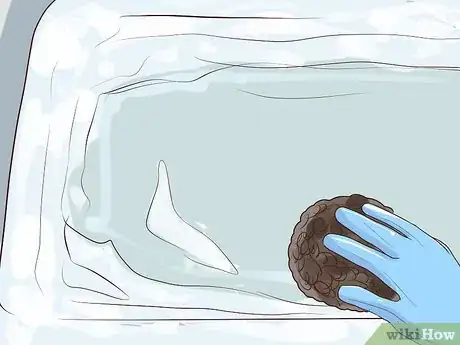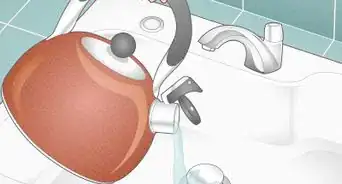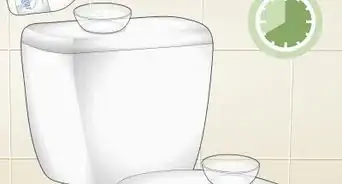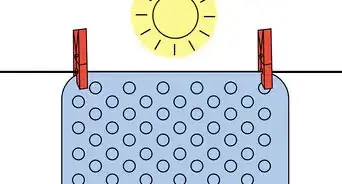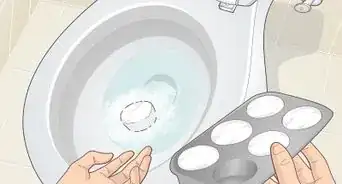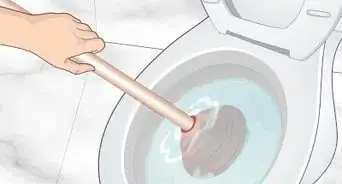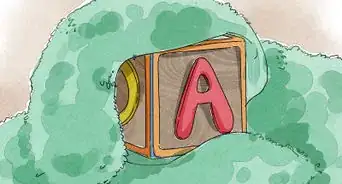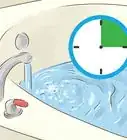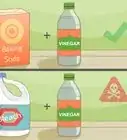This article was co-authored by Michelle Driscoll, MPH. Michelle Driscoll is the Owner of Mulberry Maids, which is based in Fort Collins, Colorado. With five years of experience, her business specializes in cleaning homes and small offices. She holds a Masters in Public Health from the Colorado School of Public Health. Additionally, Mulberry Maids has an A+ rating from the Better Business Bureau.
There are 14 references cited in this article, which can be found at the bottom of the page.
wikiHow marks an article as reader-approved once it receives enough positive feedback. This article received 14 testimonials and 83% of readers who voted found it helpful, earning it our reader-approved status.
This article has been viewed 2,141,625 times.
Nobody likes the thought of taking a soak in a dingy bathtub. With constant exposure to moisture, bacteria and mold can collect on the walls of your tub, creating a mess that’s both unsightly and unsanitary. Being diligent about keeping your bathtub clean is the best way to prevent dirt and gunk from getting out of hand, but sometimes you’ll have to bring out the big guns to chip away at heavy, set-in stains. Fortunately, this can usually be done with the aid of a few basic household products and a little elbow grease.
Steps
Removing Stains from an Acrylic Bathtub
-
1Avoid abrasive chemical cleaners. When cleaning an acrylic bathtub, stay away from harsh astringent powders such as Comet and Ajax, as well as harsh chemicals like bleach. Acrylic is a soft material and is therefore easily damaged. These types of products are almost guaranteed to ruin your tub's finish.[1]
- It's generally a good idea to start with the gentlest cleaning solution available to you and work your way up to more powerful options if that doesn't work.
-
2Spray the stains with vinegar. Distilled white vinegar makes an excellent natural cleaning solution, especially on smooth surfaces like acrylic that release stains easily. Fill a spray bottle with vinegar and keep it on hand for routine bathroom cleaning tasks. Apply the vinegar liberally to completely cover the affected area.[2]
- Lemon juice makes a fine alternative to vinegar if you happen to have some in the refrigerator.
Advertisement -
3Allow the vinegar to sit for 10-20 minutes. As it sits, the acidity in the vinegar will break down mold, grime and discoloration so that they can wiped away with ease. You may even see stains begin to dissolve and run off on their own, before you even begin scrubbing.[3]
- Make sure you give the vinegar ample time to begin working.
- For especially troublesome spots, sprinkle a little baking soda onto the vinegar as it soaks.[4]
-
4Wipe away the stains with a soft sponge. The yellow side of a normal dish sponge will do the trick. After being soaked with vinegar, dirt and grime should simply lift off with little difficulty. Use a quick back and forth scrubbing motion, and continue treating the stains until they vanish.[5]
- You can also use specialty scrubbing tools, like the Mr. Clean Magic Eraser, which are made from porous melamine foam for added stain-fighting power.[6]
-
5Rinse out the inside of the tub. Run the faucet for a few minutes to wash away every last trace of dissolved grime and dirty vinegar solution. If you’re cleaning a bathtub with an adjustable shower head, turn it on and direct the stream over the areas you just treated. Once it’s clean, the tub will need to dry so that stain-causing bacteria doesn’t return.
- Most bathtub stains are the result of germs that create a filmy residue as they accumulate.
- Leave the shower curtain drawn and switch on the overhead fan so that the tub receives steady airflow.
Removing Stains from an Enamel Bathtub
-
1Try cleaning with vinegar first. Though it’s a mild natural cleanser, vinegar will typically be potent enough to deal with most stains when applied heavily and given time to set up. Spray the tub down thoroughly, let the vinegar sit for a few minutes, then scrub away the stains using a sponge or stiff-bristled brush. If you discover that vinegar isn't having the desired effect, you can move on to more intensive methods.
- There will come a point when simply adding more and more vinegar won’t suffice.
-
2Use a bleach-free commercial cleaning spray. Products like Lysol All Purpose Cleaner, Kaboom, Shout! and Scrubbing Bubbles shower cleaner are good for eating away at tough stains without damaging delicate surfaces. Since most of these products contain a similar combination of ingredients, any of them will work as well as another. Just make sure whatever product you choose doesn’t contain bleach, as this can severely weaken the outer enamel layer of the tub.[7]
- Only buy cleaners that have been approved for use on enamel-coated bathroom surfaces. Be sure to check the label carefully before buying a particular cleaning product so you'll know you’re getting what you need.
- If possible, open a nearby window, open the door, and turn on a fan to ventilate the bathroom while you clean with any of these products.
-
3Make your own natural cleaner. If you're reluctant to go shopping, you can formulate a simple all-purpose bathroom cleaner at home by mixing together warm water, baking soda, Castile soap and essential oils in a spray bottle. All of these ingredients are readily available and safe to use but are quite potent when brought together. Once they're combined, spray the mixture onto the stained surface and give it a few minutes to take effect before wiping it away.[8]
- If you're having trouble tracking down Castile soap, hydrogen peroxide will make an acceptable substitute.
- Essential oils like tea tree and peppermint can also act as natural disinfectants.[9]
-
4Soak problem areas for several minutes. Mist on the solution and give it a chance to sit. Pay special attention to places with heavy staining and discoloration. The cleaning solution should get to work dissolving these stains right away.[10]
- The longer you let the solution sit, the more effective it will be at lifting long-settled residue.
- Wear gloves and work in a well-ventilated area when handling chemical cleaning solutions.
-
5Scrub out the stains gently. Use a soft sponge or microfiber towel to avoid leaving marks or scratches. Go over the stains using a gentle circular motion. When you’re finished, rinse away any remaining dirt and cleaning solution and let the tub dry completely.[11]
- If necessary, apply another burst of cleaning solution. Wipe and repeat until the stains come out of the enamel finish.
- Using anything more abrasive than a sponge to scrub enamel may wear down the finish.
Removing Stains from a Porcelain Bathtub
-
1Pick up a canister of abrasive cleaning powder. For thick buildup on porcelain surfaces, you’ll need to use something a little more heavy-duty. Use a product like Comet or Ajax that comes in powdered form. The small particles will be able to penetrate deeper into stains that have set up on the surface of the tub to remove them.
-
2Stick with natural alternatives. Alternately, tough stains like rust and hard water residue can be treated with a mixture of hydrogen peroxide and cream of tartar. Blend the two ingredients together until they're about the same consistency as cake frosting and spread them directly over the stains. After 10 minutes, buff the stains with a nylon brush or pumice stone until they're erased completely.[14]
- Homemade concoctions like hydrogen peroxide and cream of tartar will be preferable for those who are wary of the health and environmental effects of chemical cleaning products.
- Hydrogen peroxide will also help treat age-related discoloration and lighten the finish of the tub.[15]
-
3Sprinkle the cleaning powder around the stained tub. A moderate dusting should be enough to deal with most messes. The powder won’t stick to the surface of the porcelain on its own, but when combined with a liquid it will form a paste that can be spread directly over stains.[16]
- Be sure to cover the bottom of the tub, where accumulated mold can become a slipping hazard.
-
4Add enough water to produce a paste. Spray purified or ordinary tap water onto the cleaning powder. With the addition of moisture, the powder will take on a thick, foamy consistency. Rub this paste into the stains and give it about half an hour to take effect.[17]
- You can also wet a clean sponge or washcloth and use it to rub in the cleaner until it thickens.[18]
- Another option is to wet the tub before you apply the cleanser. Spray the tub with the shower head or fill a cup with water and pour it around the inside of the tub.
- Be careful not to add an excessive amount of water. The cleaner won’t be as effective if it’s too thin.
-
5Scour the stains with a sturdy scrubber. Since porcelain has a hard, durable finish, you can scrub it safely with an abrasive implement without worrying about scratching it up. For best results, equip a pumice stone or stiff-bristled scrubbing brush. Work on the stains until they’re completely erased, then rinse the tub with clean water and let it dry before using it again.[19]
- If you don’t own a dedicated scrubbing brush, you can use the rough green side of a kitchen sponge.
- Never use steel wool or any similar material to scour a porcelain tub. Even though porcelain is scratch-resistant, this can be enough to cause permanent damage to the finish.[20]
Expert Q&A
Did you know you can get premium answers for this article?
Unlock premium answers by supporting wikiHow
-
QuestionWe have a very old tub in a rental. How do I determine if the bathtub is porcelain or enamel?
 Michelle Driscoll, MPHMichelle Driscoll is the Owner of Mulberry Maids, which is based in Fort Collins, Colorado. With five years of experience, her business specializes in cleaning homes and small offices. She holds a Masters in Public Health from the Colorado School of Public Health. Additionally, Mulberry Maids has an A+ rating from the Better Business Bureau.
Michelle Driscoll, MPHMichelle Driscoll is the Owner of Mulberry Maids, which is based in Fort Collins, Colorado. With five years of experience, her business specializes in cleaning homes and small offices. She holds a Masters in Public Health from the Colorado School of Public Health. Additionally, Mulberry Maids has an A+ rating from the Better Business Bureau.
Founder, Mulberry Maids
-
QuestionIs there a way to remove essential oil stains from an acrylic bathtub?
 Michelle Driscoll, MPHMichelle Driscoll is the Owner of Mulberry Maids, which is based in Fort Collins, Colorado. With five years of experience, her business specializes in cleaning homes and small offices. She holds a Masters in Public Health from the Colorado School of Public Health. Additionally, Mulberry Maids has an A+ rating from the Better Business Bureau.
Michelle Driscoll, MPHMichelle Driscoll is the Owner of Mulberry Maids, which is based in Fort Collins, Colorado. With five years of experience, her business specializes in cleaning homes and small offices. She holds a Masters in Public Health from the Colorado School of Public Health. Additionally, Mulberry Maids has an A+ rating from the Better Business Bureau.
Founder, Mulberry Maids Depending on how badly the tub is stained, oil stains can be difficult. First, cover the stained area with a coat of baking soda. Then, mix up your cleaning solution in a spray bottle: 1 cup vinegar, 1 tablespoon of dish soap, and 3 cups of water. Spray this mixture over the baking soda. Use a soft sponge to scrub the stained areas. You may need to repeat this process a couple times. If you have stubborn stains, you can let the solution and baking soda sit for 15-20 minutes prior to scrubbing it away.
Depending on how badly the tub is stained, oil stains can be difficult. First, cover the stained area with a coat of baking soda. Then, mix up your cleaning solution in a spray bottle: 1 cup vinegar, 1 tablespoon of dish soap, and 3 cups of water. Spray this mixture over the baking soda. Use a soft sponge to scrub the stained areas. You may need to repeat this process a couple times. If you have stubborn stains, you can let the solution and baking soda sit for 15-20 minutes prior to scrubbing it away. -
QuestionCan you clean the tub with vinegar?
 wikiHow Staff EditorThis answer was written by one of our trained team of researchers who validated it for accuracy and comprehensiveness.
wikiHow Staff EditorThis answer was written by one of our trained team of researchers who validated it for accuracy and comprehensiveness.
Staff Answer wikiHow Staff EditorStaff AnswerYes, this should be fine. For general cleaning, make a cleaning solution of half vinegar and half water (preferably warm but not essential) and place in a spray bottle; use to clean the whole bath, wiping after spraying. For specific stains on an acrylic bath, use distilled white vinegar sprayed onto the stained area, then wipe off with water.
wikiHow Staff EditorStaff AnswerYes, this should be fine. For general cleaning, make a cleaning solution of half vinegar and half water (preferably warm but not essential) and place in a spray bottle; use to clean the whole bath, wiping after spraying. For specific stains on an acrylic bath, use distilled white vinegar sprayed onto the stained area, then wipe off with water.
Warnings
- Avoid mixing different chemical cleaners, like ammonia and bleach or vinegar and bleach. When combined, these can produce caustic fumes that may be harmful if they are inhaled or come into contact with your skin.⧼thumbs_response⧽
- Test stain removal measures on small, inconspicuous areas of your tub before getting down and dirty so you don't risk damaging the finish.⧼thumbs_response⧽
- Harsh chemicals can actually create stains on synthetic materials like acrylic. Since these stains actually change the color of the finish, they’re practically impossible to remove.⧼thumbs_response⧽
References
- ↑ https://www.angieslist.com/articles/how-clean-bathtub-right-way.htm
- ↑ http://www.bhg.com/homekeeping/house-cleaning/tips/how-to-clean-a-bathtub/
- ↑ https://www.bobvila.com/articles/cleaning-bathtub/
- ↑ https://www.apartmenttherapy.com/how-to-clean-an-old-porcelain-enamel-bathtub-or-sink-137148
- ↑ https://www.bobvila.com/articles/cleaning-bathtub/
- ↑ https://household-tips.thefuntimesguide.com/magic_erasers/
- ↑ https://www.realsimple.com/home-organizing/cleaning/bathroom-products
- ↑ http://livesimply.me/2014/09/28/diy-homemade-bathroom-cleaner/
- ↑ https://thethingswellmake.com/the-best-essential-oils-for-cleaning-and-disinfecting/
- ↑ http://jezebel.com/how-to-turn-your-stained-and-moldy-bathtubs-into-a-spa-1477132034
- ↑ https://www.pgeveryday.com/home/cleaning/article/how-to-clean-your-bathroom-in-30-minutes-or-less
- ↑ http://www.essind.com/general-cleaners/the-chemistry-of-cleaning/#Surfactants
- ↑ http://jezebel.com/how-to-turn-your-stained-and-moldy-bathtubs-into-a-spa-1477132034
- ↑ http://www.hometalk.com/871709/how-to-remove-rust-stains-from-tub?expand_all_questions=1
- ↑ https://www.hometips.com/repair-fix/bathtub-porcelain-enamel-cleaning.html
- ↑ https://www.angieslist.com/articles/how-clean-bathtub-right-way.htm
- ↑ http://jezebel.com/how-to-turn-your-stained-and-moldy-bathtubs-into-a-spa-1477132034
- ↑ https://www.bobvila.com/articles/cleaning-bathtub/#.WOAdwfkrLIU
- ↑ https://www.angieslist.com/articles/how-clean-bathtub-right-way.htm
- ↑ https://www.bobvila.com/articles/cleaning-bathtub/#.WOAdwfkrLIU
About This Article
If you’re trying to get tough stains out of an acrylic tub, opt for gentle, natural solutions, like distilled white vinegar or lemon juice. Fill a spray bottle with vinegar or lemon juice and spray it directly on the stains. Wait for 10 to 20 minutes, then wipe the area with a soft sponge to remove the grime. If you need a little extra scrubbing power, sprinkle on a little baking soda before wiping the area down. You can also use a melamine sponge to lightly scrub the area, but be gentle so you don’t scratch up your tub. Avoid using harsh cleaners that contain abrasives, like Comet, Borax, or Ajax, since they could damage the acrylic. When you’re done, rinse the tub with clean water for a few minutes to wash away any remaining dirt and grime. If your bathtub is enamel, you’ll also have to be careful of using anything too harsh or abrasive. Start with gentle cleansers, like vinegar. If that doesn’t do the trick, work your way up to tougher solutions, such as bleach-free commercial bathroom cleaners. Just check the label to make sure the product is safe to use on enamel tubs. You can also make your own cleaner by mixing warm water, baking soda, castile soap, and a few drops of your favorite essential oil in a spray bottle. Whichever cleaning solution you choose, spray it on the affected area and leave it for several minutes so it has a chance break down the stain. Use a soft sponge or microfiber cloth to gently buff the area using small, circular motions. Repeat the soak and scrub process several times if you need to. When you’re done, rinse the grime away with clean water. Porcelain bathtubs are a bit tougher, so you can safely use abrasive cleaners on this type of tub. Try a commercial cleaning powder, or make your own abrasive paste out of hydrogen peroxide and cream of tartar. Apply the powder or paste directly to the stain. If you’re using a powder, dampen it with a little water to create a paste. Scour the stain away with a sturdy scrubber, like a stiff-bristle brush or a pumice stone. Rinse the area with clean water and let it air dry when you’re done. To learn the best kind of commercial cleaners to use for your bathtub, scroll down!
